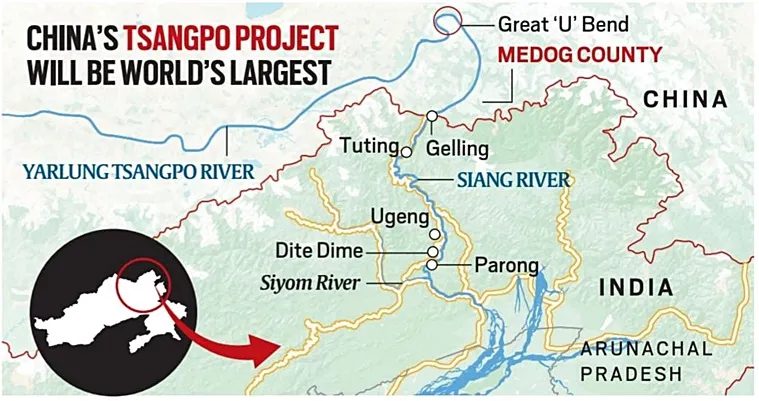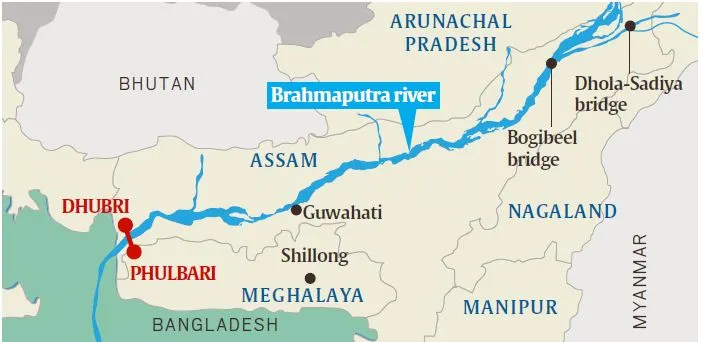International Relations
India-China Water Tensions- The Brahmaputra Factor
This editorial is based on “China’s Construction of a Dam on the Brahmaputra: A Call for Stronger Action,” published in The Indian Express on 29/07/2025. The article discusses the significant concerns arising from China’s hydropower project on the Yarlung Tsangpo River (Brahmaputra) and emphasizes the need for India to adopt a more assertive approach in addressing the risks posed by the project.
For Prelims: Brahmaputra River, Indus Waters Treaty, India-Bangladesh's Ganges Water Agreement, Upper Siang Hydroelectric Project.
For Mains: Significance of the Brahmaputra River for India, Impacts of China's Hydropower Project on India.
China's decision to build a massive hydropower project on the Yarlung Tsangpo River (Brahmaputra in Tibet) in Medog County, just 30 km from the Indian border, raises significant concerns for India. The project amplifies fears of hydro-hegemony, with potential implications for downstream flow regulation, increased flood vulnerability (water bombs), and long-term ecological degradation. Given the Brahmaputra’s significance for India’s water security and Northeast’s livelihoods, such unilateral developments pose risks to regional stability and transboundary river governance norms.
What is the Significance of the Brahmaputra River for India?
- Water Security and Agriculture: The Brahmaputra is a lifeline for India, particularly for its northeastern states like Assam, Arunachal Pradesh and Meghalaya. The river is essential for irrigation, drinking water, and industrial use in these states.
- For instance, Assam’s tea industry, one of the largest in the world, thrives due to the favorable conditions created by the river.
- These regions rely on the river's seasonal flooding for crops, making it crucial for India's food security. Any disruption in water flow could severely impact agricultural production.
- Hydropower Generation: India is focusing on hydropower projects on the Brahmaputra, particularly in Arunachal Pradesh, which has significant potential for large-scale energy generation.
- Major hydropower projects in the Brahmaputra basin include Lower Subansiri, Dibang, Kameng, and Ranganadi in Arunachal Pradesh.
- The Subansiri Hydroelectric Project alone will generate 2,000 MW of electricity, supporting India’s growing energy needs.
- Major hydropower projects in the Brahmaputra basin include Lower Subansiri, Dibang, Kameng, and Ranganadi in Arunachal Pradesh.
- Ecological and Biodiversity Significance: Brahmaputra river valleys are home to important national parks and wildlife sanctuaries (e.g., Kaziranga, Manas).
- The Brahmaputra valley and nearby low hills mostly have deciduous forests.
- Majuli, the world’s largest river island, is located in the Brahmaputra in Assam.
- The Brahmaputra's dynamic flow creates a mosaic of wetlands, oxbow lakes, and grasslands that are essential for migratory birds and aquatic species, including the endangered Gangetic river dolphin.
- Strategic Importance: The Brahmaputra River, being a transboundary river, holds strategic importance for both India and China.
- This geographic positioning elevates the river’s importance in the broader geopolitical rivalry between the two nations.
- The strategic significance of the Brahmaputra is thus not just environmental but a powerful lever in shaping India-China relations, influencing military, diplomatic, and regional security policies.
- The impact of climate change on the Tibetan Plateau, the source of the Brahmaputra, introduces an additional dimension of strategic friction in India-China relations.
- This geographic positioning elevates the river’s importance in the broader geopolitical rivalry between the two nations.
- Transportation and Connectivity: The Brahmaputra serves as a key waterway for northeastern India, facilitating trade and commerce, especially in the remote areas of Assam and Arunachal Pradesh.
- It provides an alternative to road transport, reducing congestion and fostering regional connectivity.
- The government has also been developing the National Waterway 2, which connects the Brahmaputra from Dhubri to Sadiya, enhancing India’s inland water transport infrastructure.
Note: The agreement between India and China on sharing hydrological data for the Brahmaputra River expired in June, 2023.
- Although an Expert Level Mechanism (ELM) has existed since 2006, no joint projects have materialized under cooperative agreements, and a formal bilateral treaty remains absent.
- Neither country is a party to the UN Convention on the Law of Non-Navigational Uses of International Watercourses. However, while India adheres to customary principles such as equitable use and no significant harm as demonstrated by the Indus Waters Treaty, China has shown less commitment to these norms.
What are the Potential Impacts of China's Hydropower Project on India?
- Environmental Risks and Disruption of Ecosystems: It threatens to alter the natural flow of the Brahmaputra. The contribution of glacier melt, snowmelt, and precipitation in Tibet to the waters of the Siang River is already estimated to range between 25% and 35%.
- Additionally, the construction of cascade reservoirs could disrupt aquatic ecosystems and fisheries in the Brahmaputra River basin, which provides livelihoods to millions in Assam and Arunachal Pradesh.
- Alterations in water flow and sedimentation downstream are likely to harm the ecosystem, despite claims of the project being a "run-of-the-river" initiative.
- For instance, China’s development of a cascade of smaller hydropower projects on the Mekong has affected Myanmar, Thailand, Laos, Cambodia and Vietnam.
- Also, the 2000 Siang flood in Arunachal was caused by an upstream landslide breach in Tibet, highlighting the vulnerability of the region.
- Additionally, the construction of cascade reservoirs could disrupt aquatic ecosystems and fisheries in the Brahmaputra River basin, which provides livelihoods to millions in Assam and Arunachal Pradesh.
- Geological and Seismic Risks: China’s project is being built in Seismic Zone V (very high risk).
- The construction of reservoirs and tunnels in this fragile, seismically active region raises concerns over earthquake-induced flooding.
- The Medog Fault and the Himalayan Frontal Thrust present significant geological challenges that could lead to disasters if the construction is not meticulously managed.
- Previous lapses in Chinese construction quality (e.g., in the Neelum-Jhelum project in Pakistan-Occupied Kashmir) leave little room for error in the engineering process.
- The construction of reservoirs and tunnels in this fragile, seismically active region raises concerns over earthquake-induced flooding.
- Economic Impacts on India’s Hydro-Energy Sector: Competition for water resources between the two countries will reduce India’s ability to harness hydroelectric power from the river, forcing it to rely more on alternative energy sources for its future energy needs.
- In response to China's Medog Dam project, India is considering the development of the Upper Siang Hydroelectric Project in Arunachal Pradesh, which aims to generate 11,000 MW.
- This growing competition over dam-building risks trigger a hydrological arms race, potentially threatening regional stability.
- Also, this project faces local opposition, highlighting the complex balance between energy needs, environmental concerns, and community interests.
- Displacement and Internal Security Threat: The dam has the potential to significantly alter floodplains and riverine ecosystems, risking large-scale displacement across Assam, Arunachal Pradesh, and even downstream regions in Bangladesh.
- Over 40% of Majuli Island’s landmass has already eroded, further degradation of the region is likely to intensify displacement and exacerbate socio-economic vulnerabilities.
- Also, flooding in Bangladesh could trigger cross-border migration into India, placing pressure on border regions and potentially giving rise to internal security challenges.
- Alongside, prolonged water shortages or increased flooding could trigger internal unrest in the northeastern states of India.
- Potential Halt to Diplomatic Revival and Confidence-Building Efforts: Aggressive hydropower expansion undermines recent attempts at reviving bilateral trust and people-to-people contact.
- Projects near disputed territories send negative signals during a fragile diplomatic thaw.
- Recently, India and China resumed talks on reviving the Kailash Mansarovar Yatra. Such initiatives may stall if water disputes further strain public and political trust.
What Measures Can India Adopt to Safeguard Its Interests in the Brahmaputra Basin?
- Strengthening the Joint Rivers Commission (JRC): The JRC, which currently facilitates discussions on river issues between India and Bangladesh, could be expanded to include China, ensuring that all riparian countries are consulted regarding significant infrastructure developments such as dams.
- India-Bangladesh's Ganges Water Agreement provides an example of how intergovernmental cooperation can be institutionalized for sharing water resources.
- Expanding such frameworks to include China could mitigate risks associated with unilateral actions.
- India can explore models similar to the Indus Water Treaty to foster a cooperative framework with China for the Brahmaputra Basin.
- India-Bangladesh's Ganges Water Agreement provides an example of how intergovernmental cooperation can be institutionalized for sharing water resources.
- Enhance Domestic Preparedness to Mitigate Risks: India must invest in advanced hydrological studies and monitoring systems along the Brahmaputra, ensuring it can better assess water flow, sediment patterns, and environmental impact downstream.
- This can be facilitated through technologies like satellite surveillance, remote sensing, and real-time monitoring.
- The Tehri Dam on the Bhagirathi River in Uttarakhand effectively manages flood control and water supply, providing a model for similar infrastructure on the Brahmaputra.
- Also, the National Water Development Authority has proposed two links to connect the Brahmaputra and its tributaries to the Ganga basin, enabling the transfer of surplus water to regions facing water scarcity.
- Strategic River Infrastructure as Deterrence (Non-Coercive Signalling): India can selectively prioritize and complete downstream infrastructure such as barrages and reservoirs to demonstrate first-use riparian rights and strategic preparedness.
- These projects need not be provocative but serve as credible signalling in response to unilateral upstream actions.
- This strengthens India’s negotiating position without direct confrontation.
- Such projects in Upper Siang and Dibang Valley can be part of India’s strategy to create "hydro-strategic leverage."
- Deepening Technical Cooperation with Downstream Neighbours: India can work with Bangladesh, Bhutan, and even Nepal on joint flood modeling, seasonal hydrological prediction, and emergency coordination protocols.
- A unified lower riparian bloc can add collective diplomatic weight and foster South Asian hydro-solidarity. It also supports regional climate resilience goals.
- Engage with Environmental NGOs: Partnering with NGOs that focus on transboundary rivers could help amplify India's concerns. These organizations can play an advocacy role in pushing for sustainable water management practices in international forums.
- Organizations like International Rivers and Wetland International have successfully lobbied for responsible dam construction and basin-wide ecological planning.
- By aligning with such groups, India can strengthen its voice against ecologically damaging projects and promote a rules-based river governance model.
- Building Long-Term Water Resilience: Alongside strategic and diplomatic measures, India must invest in diversifying its water sources to reduce over-dependence on transboundary rivers like the Brahmaputra.
- Alternative water sources like rainwater harvesting, desalination, and underground water storage contribute to a multi-source water security approach, enhancing national resilience against external hydrological shocks.
- Developing efficient irrigation systems in the northeastern states will help mitigate the impact of water shortages.
- Israel’s water conservation techniques and desalination plants can serve as models for India to explore alternative solutions, especially in water-scarce regions.
Conclusion
India’s response to China’s Brahmaputra projects must combine strategic preparedness, ecological prudence, and cooperative diplomacy. Strengthening infrastructure, adopting advanced technologies, and fostering regional partnerships will enhance water security and resilience. Grounding its approach in equity, intergenerational justice, and no significant harm, and aligning with global frameworks like SDG 6, the UN Watercourses Convention, and the Sendai Framework, India can transform this hydrological challenge into an opportunity for regional stability, environmental stewardship, and sustainable growth.
|
Drishti Mains Question Examine the implications of China’s hydropower project on the Brahmaputra River for India. What steps can India take to safeguard its water resources and regional stability? |
UPSC Civil Services Examination Previous Year Question (PYQ)
Prelims
Q. “Belt and Road Initiative” is sometimes mentioned in the news in the context of the affairs of: (2016)
(a) African Union
(b) Brazil
(c) European Union
(d) China
Ans: D
Mains
Q. The China-Pakistan Economic Corridor (CPEC) is viewed as a cardinal subset of China’s larger ‘One Belt One Road’ initiative. Give a brief description of CPEC and enumerate the reasons why India has distanced itself from the same. (2018)






